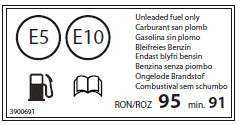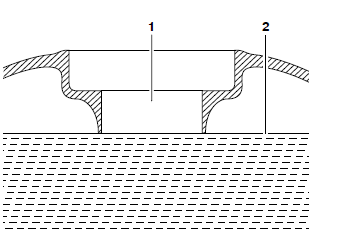 Triumph Street Triple S - Owner's Manual > Fuel
Triumph Street Triple S - Owner's Manual > Fuel


Fuel Grade
Triumph motorcycles are designed to run on unleaded gasoline with a CLC or AKI octane rating (R+M)/2 of 87 or higher. Federal regulations require that pumps delivering unleaded gasoline are marked 'UNLEADED' and that the Cost of Living Council (CLC) or Anti-Knock Index (AKI) octane rating is also displayed. These ratings are an average of the Research Octane Number (RON) and the Motor Octane Number (MON).
Ethanol
In Europe, Triumph motorcycles are compatible with Ethanol E5 and E10 (5% and 10% Ethanol) unleaded fuel.
In all other markets Ethanol up to E25 (25% Ethanol) may be used.
Engine Calibration
In certain circumstances engine calibration may be required. Always refer to your authorized Triumph dealer.
Caution: The motorcycle can be permanently damaged if it is allowed to operate with the incorrect grade of fuel or incorrect engine calibration.
Always make sure the fuel used is of the correct grade and quality.
Damage caused by using the incorrect fuel or engine calibration is not considered a manufacturing defect and will not be covered under warranty.
Caution: The exhaust system for this motorcycle is equipped with a catalytic converter to help reduce exhaust emission levels.
Use of leaded fuel will damage the catalytic converter. In addition, the catalytic converter can be permanently damaged if the motorcycle is allowed to run out of fuel or if the fuel level is allowed to get very low.
Always make sure you have adequate fuel for your trip.
Note: The use of leaded fuel is illegal in some countries, states or territories.
Note: If 'knocking' or 'pinging' occurs at a steady engine speed under normal load, use a different brand of gasoline or gasoline which has a higher octane rating.
Oxygenated Gasoline
To help in meeting clean air standards, some areas of the U.S. use oxygenated gasoline to help reduce harmful emissions. These gasolines are a blend of conventional gasoline and another compound such as alcohol. This Triumph motorcycle will give its best performance when using unleaded gasoline. However, the following should be used as a guide if you use any oxygenated fuels.
Ethanol
Ethanol fuel is a mixture of 10% Ethanol and 90% gasoline and is often described under the names 'gasohol', 'Ethanol enhanced', or 'contains Ethanol'. This fuel may be used in your Triumph motorcycle.
MTBE (Methyl Tertiary Butyl Ether)
The use of gasolines containing up to 15% MTBE (Methyl Tertiary Butyl Ether) is permitted in this Triumph motorcycle.
Methanol
Fuels containing methanol should not be used as damage to components in the fuel system can be caused by contact with methanol.
Note: Because of the generally higher volatility of oxygenated fuels, starting, engine response and fuel consumption may be adversely affected by their use.
Should any of these difficulties be experienced, run the motorcycle on normal unleaded gasoline.
Refueling
Warning: To help reduce hazards associated with refueling, always observe the following fuel safety instructions:
- Gasoline (fuel) is highly flammable and can be explosive under certain conditions. When refueling, turn the ignition switch to the OFF position.
- Do not smoke.
- Do not use a mobile telephone.
- Make sure the refueling area is well ventilated and free from any source of flame or sparks. This includes any appliance with a pilot light.
- Never fill the tank until the fuel level rises into the filler neck. Heat from sunlight or other sources may cause the fuel to expand and overflow creating a fire hazard.
- After refueling always check that the fuel filler cap is correctly closed.
- Because gasoline (fuel) is highly flammable, any fuel leak or spillage, or any failure to observe the safety advice given above will lead to a fire hazard, which could cause damage to property, injury to persons or death.
Fuel Tank Cap

- Fuel tank cap
- Key
To open the fuel tank cap, lift up the flap covering the lock. Insert the key into the lock and turn the key clockwise.
To close and lock the cap, push the cap down into place with the key inserted, until the lock clicks into place. Withdraw the key and close the key cover.
Caution: Closing the cap without the key inserted will damage the cap, tank and lock mechanism.
Filling the Fuel Tank
Warning: Overfilling the tank can lead to fuel spillage.
If fuel is spilled, thoroughly clean up the spillage immediately and dispose of the materials used safely.
Take care not to spill any fuel on the engine, exhaust pipes, tires or any other part of the motorcycle.
Because fuel is highly flammable, any fuel leak or spillage, or any failure to observe the safety advice given above may lead to a fire hazard, which could cause damage to property and injury or death to persons.
Fuel spilled near to, or onto the tires will reduce the tires' ability to grip the road. This will result in a dangerous riding condition potentially causing loss of motorcycle control and an accident.
Caution: Avoid filling the tank in rainy or dusty conditions where airborne material can contaminate the fuel.
Contaminated fuel may cause damage to fuel system components.
Fill the fuel tank slowly to help prevent spillage. Do not fill the tank to a level above the bottom of the filler neck. This will make sure there is enough air space to allow for fuel expansion if the fuel inside the tank expands through absorption of heat from the engine or from direct sunlight.

- Fuel filler neck
- Maximum fuel level
After refueling always check that the fuel filler cap is correctly closed.
Traction Control (TC)
Warning: Traction control is not a substitute for riding appropriately for the prevailing road and weather conditions.
The traction control cannot prevent loss of traction due to:
- Excessive speed when entering turns
- Accelerating at a sharp lean angle
- Braking
- Traction control cannot prevent the front wheel from slipping.
Failure to observe any of the above may result in loss of motorcycle control and an accident.
Traction control helps to maintain traction when accelerating on wet/ slippery road surfaces. If sensors detect that the rear wheel is losing traction (slipping), the traction control system will engage and alter the engine power until traction to the rear wheel has been restored. The traction control warning light will flash while it is engaged and the rider may notice a change to the sound of the engine.
Note: Traction control will not function if there is a malfunction with the ABS system.
The warning lights for the ABS, traction control and the MIL will be illuminated.
Traction Control Settings
Warning: Do not attempt to adjust the traction control settings while the motorcycle is in motion as this may lead to loss of motorcycle control and an accident.
Warning: If the traction control is disabled, the motorcycle will handle as normal but without traction control. In this situation accelerating too hard on wet/slippery road surfaces may cause the rear wheel to slip, and may result in loss of motorcycle control and an accident.
The traction control can be set as described on page 49 for Street Triple RS models, or on page 79 for all other models.
If traction control is turned OFF, the TC disabled warning light will be illuminated.
The traction control defaults to ON after the ignition has been switched OFF and then switched ON again.
See also:
 Triumph Street Triple S - Owner's Manual > Riding Mode Selection
Triumph Street Triple S - Owner's Manual > Riding Mode Selection
Warning: After selecting a riding mode, operate the motorcycle in an area free from traffic to gain familiarity with the new settings. Do not loan your motorcycle to anyone as they may change the riding mode settings from the one you are familiar with, causing loss of motorcycle control and an accident.
 Triumph Street Triple S - Owner's Manual > Tire Pressure Monitoring System (TPMS)
Triumph Street Triple S - Owner's Manual > Tire Pressure Monitoring System (TPMS)
(if equipped) Note: The Tire Pressure Monitoring System (TPMS) is available as an accessory option on all models and must be installed by your authorized Triumph dealer. The TPMS display on the instruments will only be activated when the system has been installed.

 Benelli Imperiale 400
Benelli Imperiale 400 BMW F900XR
BMW F900XR Honda CB500X
Honda CB500X KTM 390 Adventure
KTM 390 Adventure Triumph Street Triple S
Triumph Street Triple S Yamaha MT-03
Yamaha MT-03 Kawasaki Z400
Kawasaki Z400 Triumph Street Triple S
Triumph Street Triple S Yamaha MT-03
Yamaha MT-03